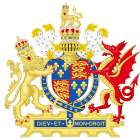Act for the Marriage of Queen Mary to Philip of Spain
 | |
| Citation | 1 Mar. Sess. 3 c. 2 |
|---|---|
| Territorial extent | Kingdom of England |
| Dates | |
| Royal assent | April 1554 |
| Repealed | 1863 |
| Other legislation | |
| Repealed by | Statute Law Revision Act 1863 |
| Relates to | |
Status: Repealed | |
| Text of statute as originally enacted | |
The Act for the Marriage of Queen Mary to Philip of Spain or Queen Mary's Marriage Act (1 Mar. Sess. 3 c. 2) was passed by the Parliament of England in April 1554 to regulate the future marriage and joint reign of Queen Mary I and Philip, son of the Holy Roman Emperor Charles V and Prince of Asturias.
In reality, the Act seems to have served as a business contract between England and Spain; it specifies what Spain could expect from the union, while at the same time assuring the English that England would not become a satellite of Spain.
Under the terms of the marriage treaty, Philip was to enjoy his wife's titles and honours as King of England and Ireland for as long as their marriage should last. All official documents, including Acts of Parliament, were to be dated with both their names (with Philip's preceding Mary's as deemed proper for husband and wife), and Parliament was to be called under the joint authority of the couple. The Act stated that King Philip would take part in governing Mary's realms while reserving most authority for Mary herself. Formally, King Philip was to co-reign with his wife according to the Act, which nevertheless ensured that the new king would not become too powerful by prohibiting him from appointing foreigners to any offices, taking his wife or any child that might be born to them outside her realm and claiming the crown for himself should he outlive his wife.[1]
The Act presumed that the Queen would have children by the Prince and allowed full personal union between England and Ireland and all the realms Philip was to inherit from his father or from his grandmother, Queen Joanna of Castile and Aragon, but only should Philip's previous son Charles die childless.
The Act was repealed by the Statute Law Revision Act 1863.
See also
References
- ^ Louis Adrian Montrose, The subject of Elizabeth: authority, gender, and representation, University of Chicago Press, 2006
